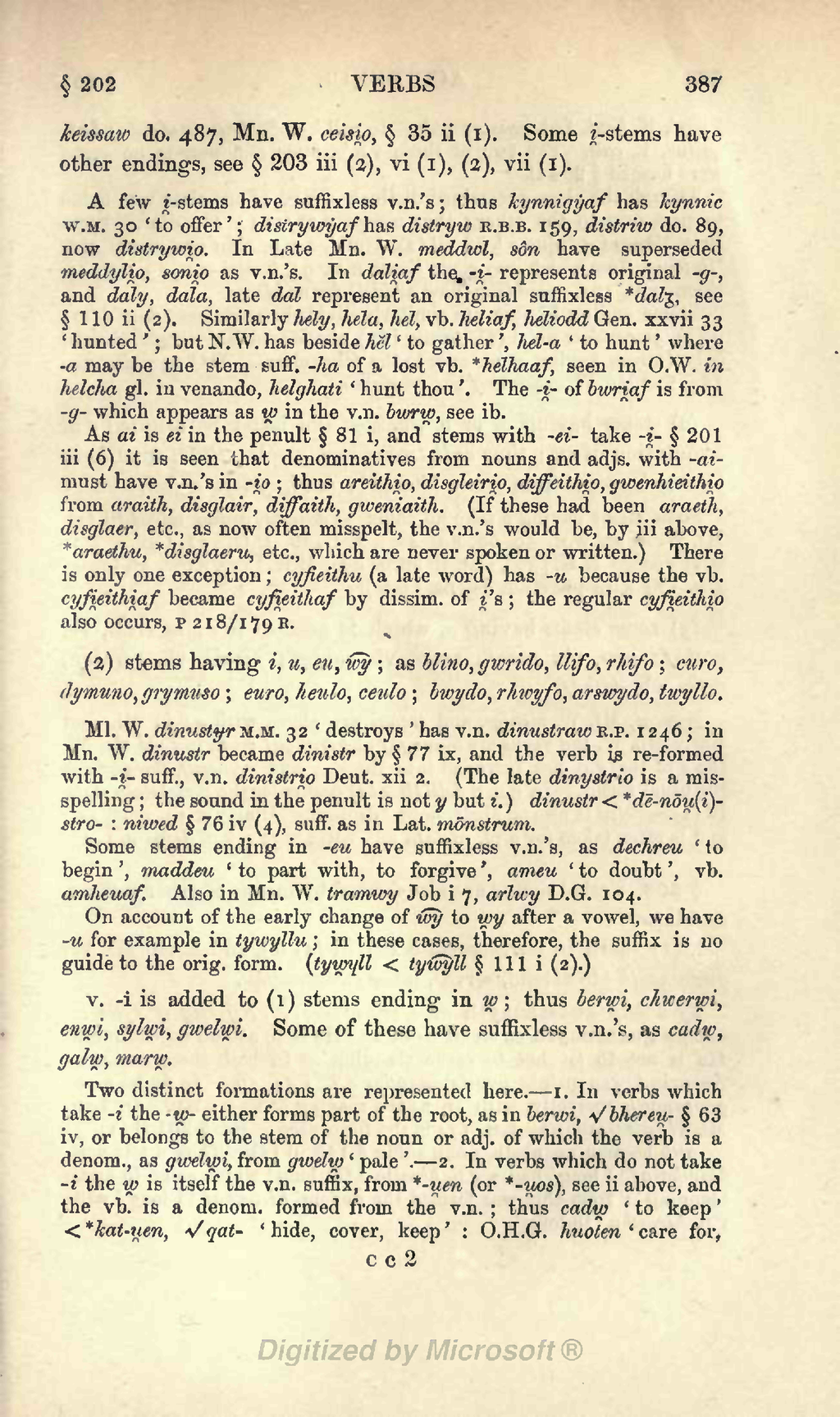keissaw do. 487, Mn. W. ceisio, 35 ii (i). Some -stems have other endings, see 203 iii (a), vi (i), (a), vii (i).
A few i-stems have suffixless v.n.'s ; thus kynnigyaf has Icynnic W.M. 30 'to offer'; disirywyaf has distryw E.B.B. 159, distriw do. 89, now distrywio. In Late Mn. W. meddwl, son have superseded meddylio, sonio as v.n.'s. In daliaf the. -i- represents original -g-, and daly, ddla, late dal represent an original suffixless *dal%, see 1 10 ii (2). Similarly hely, hela, hel, vh. Jieliaf, heliodd Gen. xxvii 33 ' hunted ' ; but N.W. has beside hel ' to gather ', hel-a ' to hunt ' where -a may be the stem suff. -ha of a lost vb. *helhaaf, seen in O.W. in helcha gl. in venando, helghati ' hunt thou '. The -i- of bwriaf is from -g- which appears as w in the v.n. bwrw, see ib.
As ai is ei in the penult 81 i, and stems with -ei- take -*- 201 iii (6) it is seen that denominatives from nouns and adjs. with -ai- must have v.n.'s in -io ; thus areithio, disgleirio, diffeithio,gwenhieithio from araith, disglair, dijfaith, gweniaith. (If these had been araeth, disglaer, etc., as now often misspelt, the v.n.'s would be, by iii above,
- araethu, *disglaeru, etc., which are never spoken or written.) There
is only one exception ; cyfieiihu (a late word) has -u because the vb. cyfieithiaf became cyfieithaf by dissim. of i's ; the regular cyfieithio also occurs, P 2 1 8/1 79 K.
(a) stems having i, u, en, wy ; as blino, gwrido, llifo, rHfo ; euro, dymunO) grymM&o ; euro, heulo, ceulo ; bwydo, rhivyfo, arswydo, twyllo.
Ml. W. dinustyr M.M. 32 ' destroys ' has v.n. dinustraw K.P. 1246; in Mn. W. dinustr became dinistr by 77 ix, and the verb is re-formed with -i- suff., v.n. dinistrio Deut. xii 2. (The late dinystrio is a mis- spelling ; the sound in the penult is not y but i. ) dinustr < *de-nou(i)- stro- : niwed 76 iv (4), suff. as in Lat. monstrum.
Some stems ending in -eu have suffixless v.n.'s, as dechreu ' to begin ', madden ' to part with, to forgive ', ameu ' to doubt ', vb. amheuaf. Also in Mn. W. tramwy Job i 7, arlwy D.G. 104.
On account of the early change of wy to wy after a vowel, we have -u for example in tywyllu ; in these cases, therefore, the suffix is no guide to the orig. form, (tyunfll < tywyll 1 1 1 i (2).)
v. -i is added to (i) stems ending in w ; thus berwi, cAwerwi, enwi, sylwi, gwelwi. Some of these have suffixless v.n.'s, as cadw, galw, marw.
Two distinct formations are represented here. i. In verbs which take -i the -w- either forms part of the root, as in berwi, Vbhereu- 63 iv, or belongs to the stem of the noun or adj. of which the verb is a denom., as gwelwi, from gwelw ' pale '. 2. In verbs which do not take -t the w is itself the v.n. suffix, from *-uen (or *-uos), see ii above, and the vb. is a denom. formed from the v.n. ; thus cadw ' to keep ' <*kat-uen, Vqat- 'hide, cover, keep' : O.H.G. huoten'c&re for,
